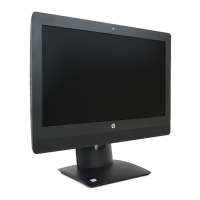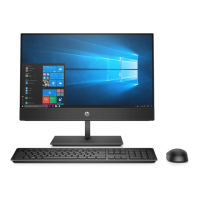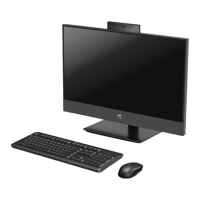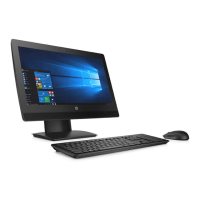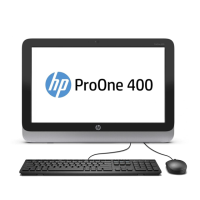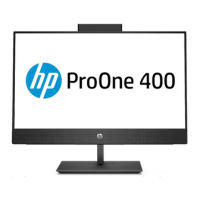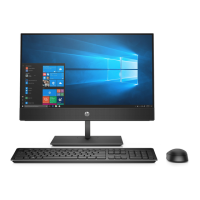
Do you have a question about the HP ProOne 600 G5 and is the answer not in the manual?
| Processor | Intel Core i3/i5/i7/i9, Intel Pentium, Intel Celeron |
|---|---|
| RAM | Up to 64 GB DDR4 |
| Storage | Up to 2TB HDD, up to 1TB SSD |
| Display | 21.5" diagonal FHD (1920 x 1080) IPS anti-glare WLED-backlit |
| Graphics | Intel UHD Graphics 630 |
| Operating System | Windows 10 Pro |
| Ports | USB 3.1 Gen 1, USB-C, HDMI, DisplayPort, RJ-45, audio jack |
| Network | Gigabit Ethernet |
| Chipset | Intel® Q370 |
| Audio | Integrated stereo speakers |
| Networking | optional Wi-Fi 6, Bluetooth 5.0 |
| Power Supply | up to 89% efficiency |
Provides a general introduction to the product's features and components.
Details the components located on the front of the computer.
Details the components located on the sides of the computer.
Details the components located on the rear of the computer.
Details the components located on the bottom of the computer.
Explains the location and purpose of various labels on the computer.
Lists and illustrates various system components available for the computer.
Lists available mass storage devices like hard drives and SSDs.
Lists available processors and memory modules for the computer.
Lists various keyboard and mouse options for the computer.
Explains the risks of ESD and precautions to prevent damage to components.
Details methods and equipment for preventing ESD damage.
Describes personal grounding techniques and necessary equipment for ESD protection.
Lists materials and equipment for preventing static electricity.
Provides guidelines for operating the computer to prevent overheating and prolong life.
Outlines general safety rules for cleaning computer components.
Provides instructions for cleaning the computer case.
Provides instructions for cleaning the computer keyboard.
Provides instructions for cleaning the computer display screen.
Provides instructions for cleaning the computer mouse.
Lists tools and software needed for computer servicing.
Discusses screw types, interchangeability, and handling during disassembly.
Provides guidance on handling and routing internal computer cables.
Offers advice on handling, installing, and removing hard drives.
Details information and warnings related to the lithium coin cell battery.
Provides specific instructions for handling SATA data cables.
Offers best practices for managing cables inside the computer.
Outlines essential steps before disassembling the computer.
Details the procedure for removing the computer stand.
Explains how to remove and install the VESA mounting bracket.
Provides steps for removing and replacing the webcam module.
Details the procedure for removing the rear port cover.
Identifies internal components accessible after removing the rear port cover.
Step-by-step guide for removing and replacing the hard drive.
Step-by-step guide for removing and replacing the optical drive.
Provides instructions for removing and installing an M.2 solid-state drive.
Details memory module specifications and installation procedures.
Explains how to replace the computer's lithium coin cell battery.
Provides instructions for removing and installing the WLAN module.
Details the procedure for removing and installing the option board.
Provides instructions for removing and replacing the hood sensor.
Details the steps for removing and replacing the fan assembly.
Provides instructions for removing and replacing the heat sink.
Explains how to remove and install the computer's processor.
Details the procedure for removing and replacing the system board.
Provides instructions for removing and replacing the internal computer speakers.
Details the procedure for removing and replacing the power button board.
Explains the complex process of removing the rear enclosure and display assembly.
Provides instructions for removing and installing the computer antennas.
Advises on safe and comfortable work environment practices.
Lists steps to take before contacting HP support for assistance.
Offers solutions for common computer operational issues.
Provides troubleshooting steps for power-related issues.
Offers solutions for common hard drive errors and issues.
Provides troubleshooting steps for audio output issues.
Offers troubleshooting steps for common printer issues.
Provides troubleshooting steps for keyboard and mouse issues.
Offers solutions for problems encountered during hardware installation.
Provides troubleshooting steps for network connectivity issues.
Offers troubleshooting steps for memory-related issues.
Provides troubleshooting steps for USB flash drive issues.
Offers troubleshooting steps for Internet connectivity problems.
Provides troubleshooting steps for common software issues.
Explains how to use the Computer Setup utility for system configuration.
Details the options available in the Main section of Computer Setup.
Explains security settings and password management in Computer Setup.
Covers advanced configuration options in Computer Setup.
Lists POST error codes and their recommended actions.
Explains how to interpret system diagnostic codes and LED indicators.
Provides steps to reset system passwords via a jumper.
Details how to clear and reset BIOS settings to defaults.
Guide to using HP PC Hardware Diagnostics within Windows.
Instructions on how to launch HP PC Hardware Diagnostics from UEFI.
Guide to creating a bootable USB for HP PC Hardware Diagnostics UEFI.
Explains how to customize remote diagnostics settings.
Covers backing up data and creating recovery media using Windows.
Discusses options for restoring, resetting, and refreshing the computer.
Details how to modify the system's boot sequence.
Explains how to use HP Sure Recover for OS restoration.
Outlines general requirements for power cord sets applicable to all countries.
Specifies requirements for power cord sets used in Japan.
Lists additional power cord requirements for various countries.
Provides steps to restore nonvolatile memory and BIOS settings.
Details the usage and characteristics of nonvolatile memory types.
Explains how to reset BIOS settings to their factory defaults.
Details the procedure for resetting Custom Secure Boot Keys.

